KIA Sorento 2006 1.G Repair Manual
Manufacturer: KIA, Model Year: 2006, Model line: Sorento, Model: KIA Sorento 2006 1.GPages: 312, PDF Size: 5.21 MB
Page 61 of 312
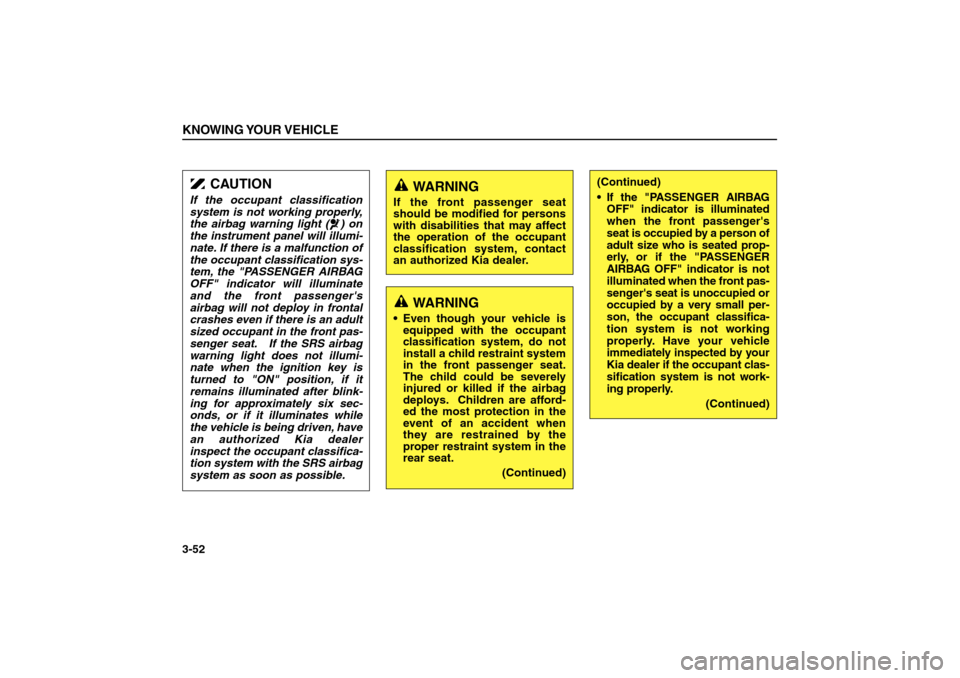
KNOWING YOUR VEHICLE3-52
WARNING
If the front passenger seat
should be modified for persons
with disabilities that may affect
the operation of the occupant
classification system, contact
an authorized Kia dealer.
WARNING
Even though your vehicle is
equipped with the occupant
classification system, do not
install a child restraint system
in the front passenger seat.
The child could be severely
injured or killed if the airbag
deploys. Children are afford-
ed the most protection in the
event of an accident when
they are restrained by the
proper restraint system in the
rear seat.
(Continued)
(Continued)
If the "PASSENGER AIRBAG
OFF" indicator is illuminated
when the front passenger's
seat is occupied by a person of
adult size who is seated prop-
erly, or if the "PASSENGER
AIRBAG OFF" indicator is not
illuminated when the front pas-
senger's seat is unoccupied or
occupied by a very small per-
son, the occupant classifica-
tion system is not working
properly. Have your vehicle
immediately inspected by your
Kia dealer if the occupant clas-
sification system is not work-
ing properly.
(Continued)
CAUTION
If the occupant classification
system is not working properly,
the airbag warning light ( ) on
the instrument panel will illumi-
nate. If there is a malfunction of
the occupant classification sys-
tem, the "PASSENGER AIRBAG
OFF" indicator will illuminate
and the front passenger's
airbag will not deploy in frontal
crashes even if there is an adult
sized occupant in the front pas-
senger seat. If the SRS airbag
warning light does not illumi-
nate when the ignition key is
turned to "ON" position, if it
remains illuminated after blink-
ing for approximately six sec-
onds, or if it illuminates while
the vehicle is being driven, have
an authorized Kia dealer
inspect the occupant classifica-
tion system with the SRS airbag
system as soon as possible.
BL-ENG (CAN)-3.qxd 7/28/05 5:52 PM Page 52
Page 62 of 312
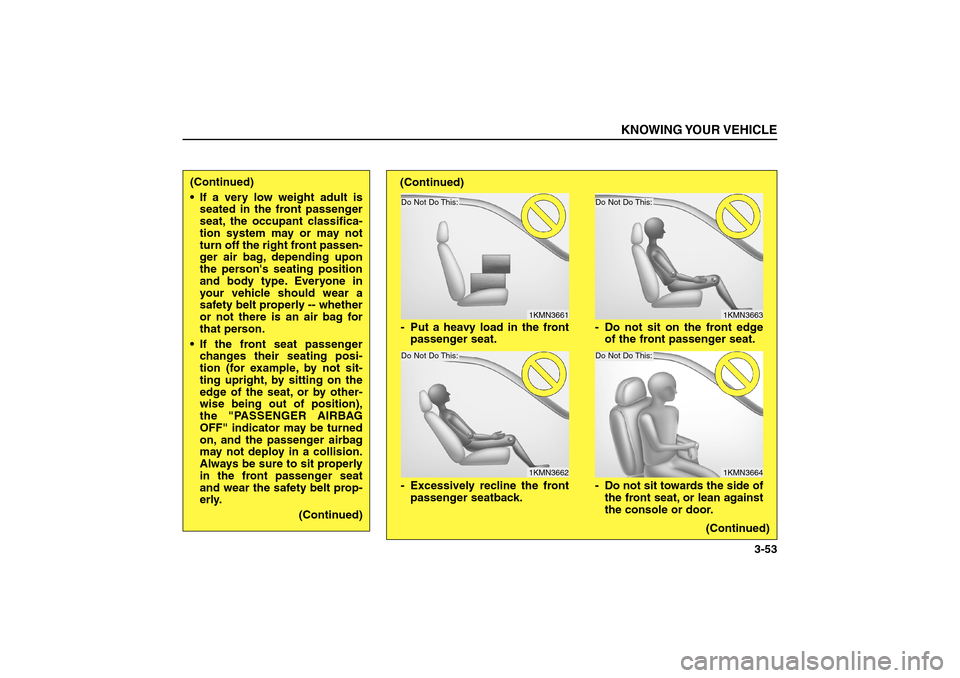
KNOWING YOUR VEHICLE
3-53
(Continued)
If a very low weight adult is
seated in the front passenger
seat, the occupant classifica-
tion system may or may not
turn off the right front passen-
ger air bag, depending upon
the person's seating position
and body type. Everyone in
your vehicle should wear a
safety belt properly -- whether
or not there is an air bag for
that person.
If the front seat passenger
changes their seating posi-
tion (for example, by not sit-
ting upright, by sitting on the
edge of the seat, or by other-
wise being out of position),
the "PASSENGER AIRBAG
OFF" indicator may be turned
on, and the passenger airbag
may not deploy in a collision.
Always be sure to sit properly
in the front passenger seat
and wear the safety belt prop-
erly.
(Continued)
1KMN3661
Do Not Do This:Do Not Do This:
1KMN3662
1KMN36631KMN3664
- Put a heavy load in the front
passenger seat.
- Excessively recline the front
passenger seatback.- Do not sit on the front edge
of the front passenger seat.
- Do not sit towards the side of
the front seat, or lean against
the console or door.
Do Not Do This:Do Not Do This:
(Continued)
(Continued)
BL-ENG (CAN)-3.qxd 7/28/05 5:52 PM Page 53
Page 63 of 312
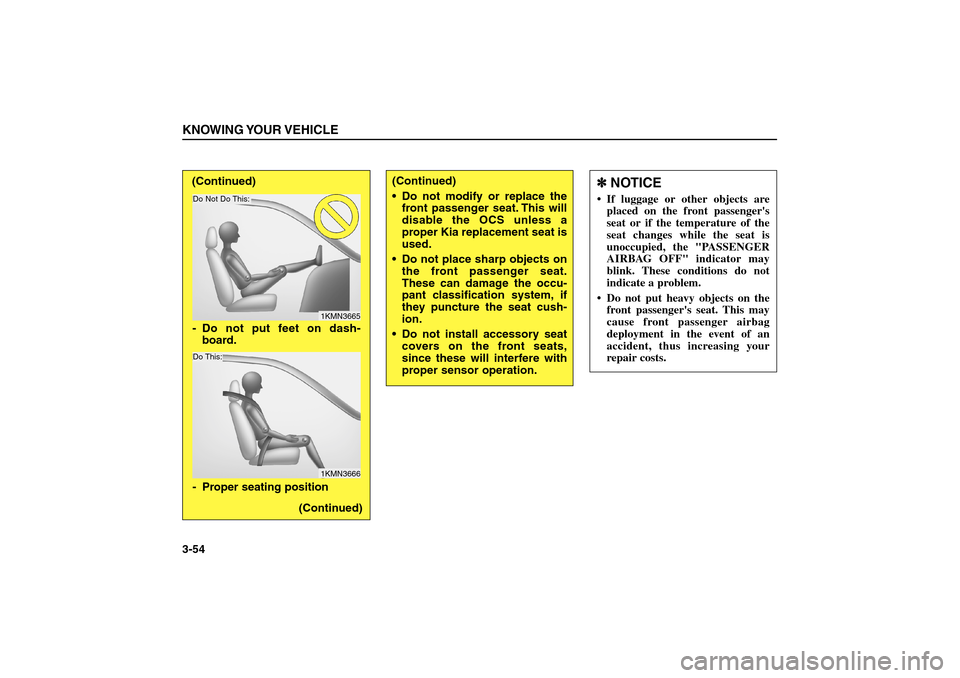
KNOWING YOUR VEHICLE3-54
(Continued)
Do not modify or replace the
front passenger seat. This will
disable the OCS unless a
proper Kia replacement seat is
used.
Do not place sharp objects on
the front passenger seat.
These can damage the occu-
pant classification system, if
they puncture the seat cush-
ion.
Do not install accessory seat
covers on the front seats,
since these will interfere with
proper sensor operation.
✽ ✽
NOTICE If luggage or other objects are
placed on the front passenger's
seat or if the temperature of the
seat changes while the seat is
unoccupied, the "PASSENGER
AIRBAG OFF" indicator may
blink. These conditions do not
indicate a problem.
Do not put heavy objects on the
front passenger's seat. This may
cause front passenger airbag
deployment in the event of an
accident, thus increasing your
repair costs.
1KMN36651KMN3666
- Proper seating position - Do not put feet on dash-
board.
(Continued) (Continued)Do Not Do This:Do This:
BL-ENG (CAN)-3.qxd 7/28/05 5:52 PM Page 54
Page 64 of 312
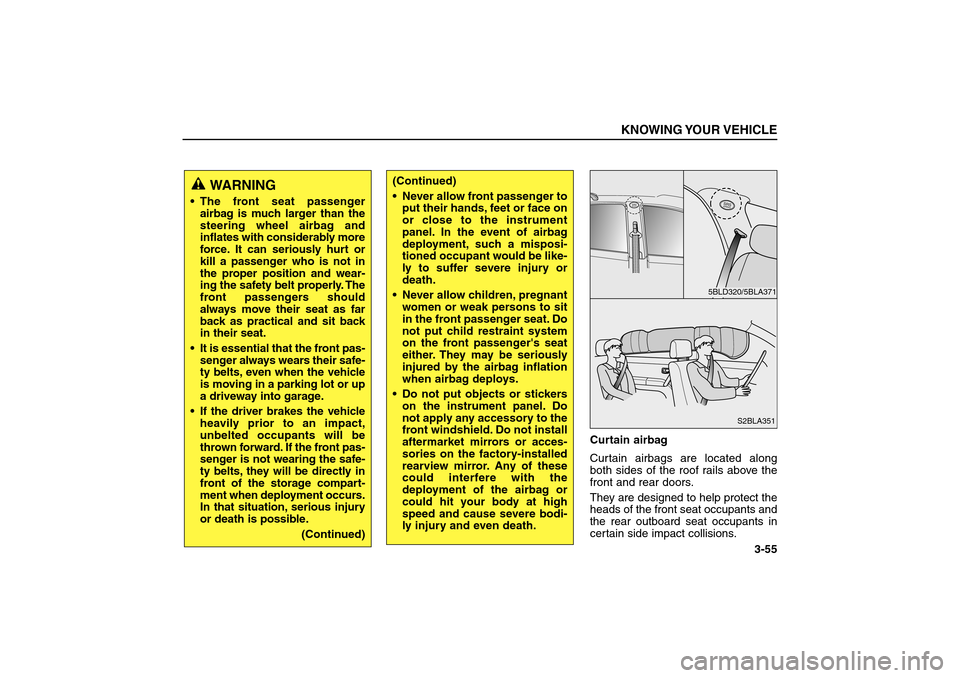
Curtain airbag
Curtain airbags are located along
both sides of the roof rails above the
front and rear doors.
They are designed to help protect the
heads of the front seat occupants and
the rear outboard seat occupants in
certain side impact collisions.
KNOWING YOUR VEHICLE
3-55
S
R
SAIRBAG
5BLD320/5BLA371
S2BLA351
SRSAIRBAG
(Continued)
Never allow front passenger to
put their hands, feet or face on
or close to the instrument
panel. In the event of airbag
deployment, such a misposi-
tioned occupant would be like-
ly to suffer severe injury or
death.
Never allow children, pregnant
women or weak persons to sit
in the front passenger seat. Do
not put child restraint system
on the front passenger's seat
either. They may be seriously
injured by the airbag inflation
when airbag deploys.
Do not put objects or stickers
on the instrument panel. Do
not apply any accessory to the
front windshield. Do not install
aftermarket mirrors or acces-
sories on the factory-installed
rearview mirror. Any of these
could interfere with the
deployment of the airbag or
could hit your body at high
speed and cause severe bodi-
ly injury and even death.
WARNING
The front seat passenger
airbag is much larger than the
steering wheel airbag and
inflates with considerably more
force. It can seriously hurt or
kill a passenger who is not in
the proper position and wear-
ing the safety belt properly. The
front passengers should
always move their seat as far
back as practical and sit back
in their seat.
It is essential that the front pas-
senger always wears their safe-
ty belts, even when the vehicle
is moving in a parking lot or up
a driveway into garage.
If the driver brakes the vehicle
heavily prior to an impact,
unbelted occupants will be
thrown forward. If the front pas-
senger is not wearing the safe-
ty belts, they will be directly in
front of the storage compart-
ment when deployment occurs.
In that situation, serious injury
or death is possible.
(Continued)
BL-ENG (CAN)-3.qxd 7/28/05 5:52 PM Page 55
Page 65 of 312
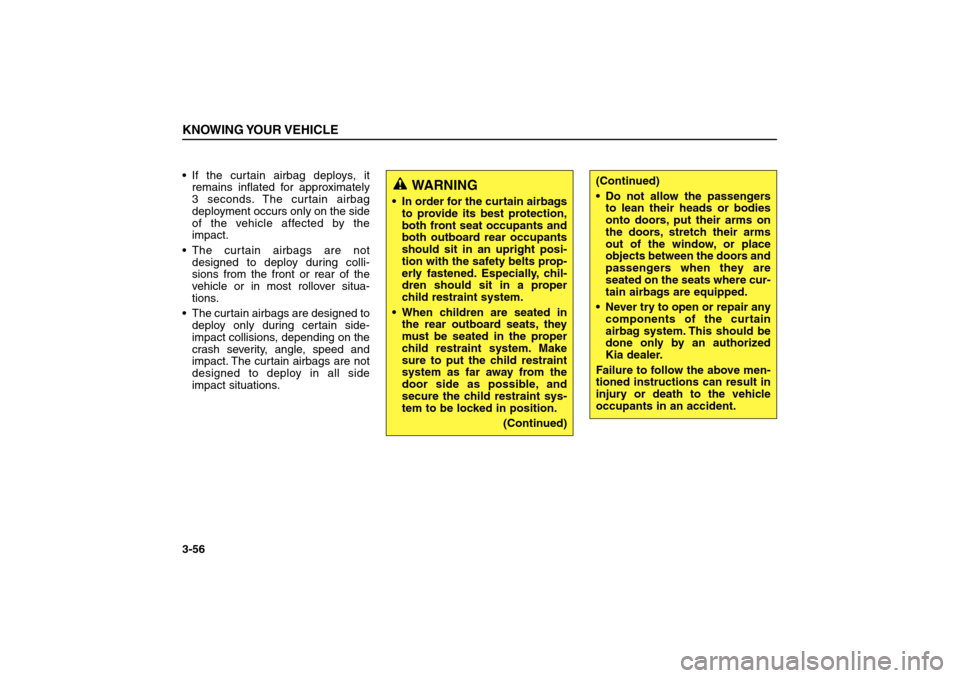
If the curtain airbag deploys, it
remains inflated for approximately
3 seconds. The curtain airbag
deployment occurs only on the side
of the vehicle affected by the
impact.
The curtain airbags are not
designed to deploy during colli-
sions from the front or rear of the
vehicle or in most rollover situa-
tions.
The curtain airbags are designed to
deploy only during certain side-
impact collisions, depending on the
crash severity, angle, speed and
impact. The curtain airbags are not
designed to deploy in all side
impact situations.KNOWING YOUR VEHICLE3-56
WARNING
In order for the curtain airbags
to provide its best protection,
both front seat occupants and
both outboard rear occupants
should sit in an upright posi-
tion with the safety belts prop-
erly fastened. Especially, chil-
dren should sit in a proper
child restraint system.
When children are seated in
the rear outboard seats, they
must be seated in the proper
child restraint system. Make
sure to put the child restraint
system as far away from the
door side as possible, and
secure the child restraint sys-
tem to be locked in position.
(Continued)
(Continued)
Do not allow the passengers
to lean their heads or bodies
onto doors, put their arms on
the doors, stretch their arms
out of the window, or place
objects between the doors and
passengers when they are
seated on the seats where cur-
tain airbags are equipped.
Never try to open or repair any
components of the curtain
airbag system. This should be
done only by an authorized
Kia dealer.
Failure to follow the above men-
tioned instructions can result in
injury or death to the vehicle
occupants in an accident.
BL-ENG (CAN)-3.qxd 7/28/05 5:52 PM Page 56
Page 66 of 312
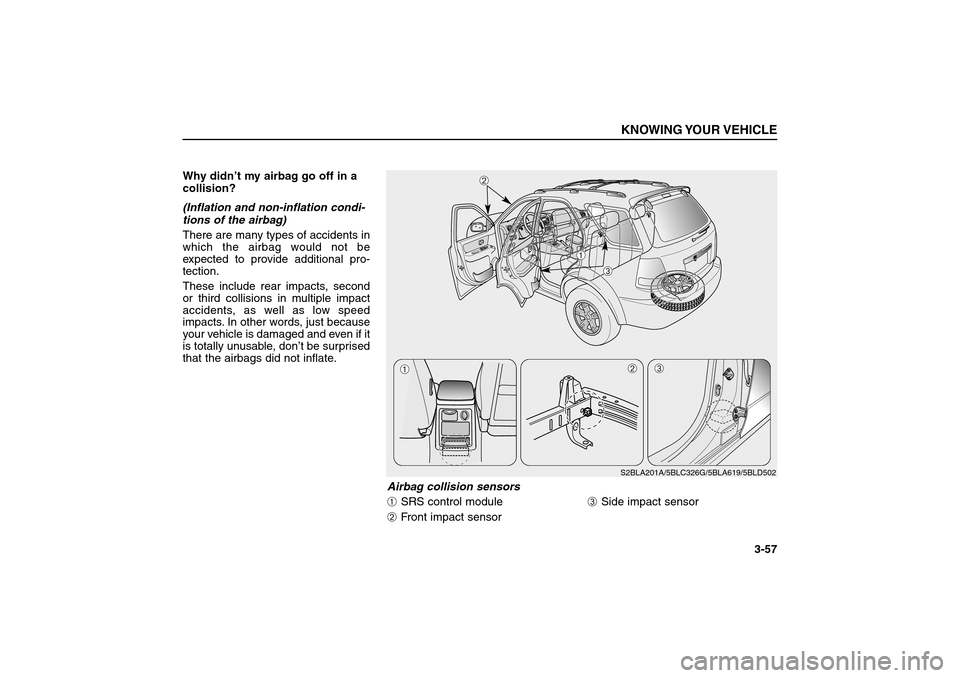
Why didn’t my airbag go off in a
collision?
(Inflation and non-inflation condi-
tions of the airbag)
There are many types of accidents in
which the airbag would not be
expected to provide additional pro-
tection.
These include rear impacts, second
or third collisions in multiple impact
accidents, as well as low speed
impacts. In other words, just because
your vehicle is damaged and even if it
is totally unusable, don’t be surprised
that the airbags did not inflate.
KNOWING YOUR VEHICLE
3-57
Airbag collision sensors➀
SRS control module
➁
Front impact sensor
➂
Side impact sensor
S2BLA201A/5BLC326G/5BLA619/5BLD502
➀
➁
➂
➀
➁
➂
BL-ENG (CAN)-3.qxd 7/28/05 5:52 PM Page 57
Page 67 of 312
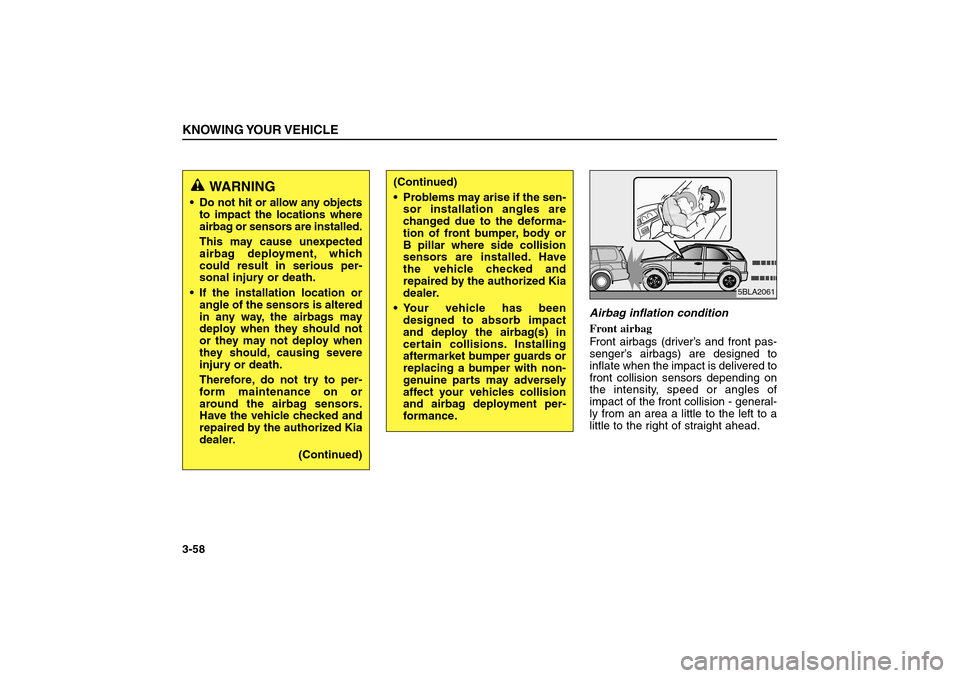
Airbag inflation condition
Front airbag
Front airbags (driver’s and front pas-
senger’s airbags) are designed to
inflate when the impact is delivered to
front collision sensors depending on
the intensity, speed or angles of
impact of the front collision - general-
ly from an area a little to the left to a
little to the right of straight ahead.
KNOWING YOUR VEHICLE3-58
WARNING
Do not hit or allow any objects
to impact the locations where
airbag or sensors are installed.
This may cause unexpected
airbag deployment, which
could result in serious per-
sonal injury or death.
If the installation location or
angle of the sensors is altered
in any way, the airbags may
deploy when they should not
or they may not deploy when
they should, causing severe
injury or death.
Therefore, do not try to per-
form maintenance on or
around the airbag sensors.
Have the vehicle checked and
repaired by the authorized Kia
dealer.
(Continued)
(Continued)
Problems may arise if the sen-
sor installation angles are
changed due to the deforma-
tion of front bumper, body or
B pillar where side collision
sensors are installed. Have
the vehicle checked and
repaired by the authorized Kia
dealer.
Your vehicle has been
designed to absorb impact
and deploy the airbag(s) in
certain collisions. Installing
aftermarket bumper guards or
replacing a bumper with non-
genuine parts may adversely
affect your vehicles collision
and airbag deployment per-
formance.
5BLA2061
BL-ENG (CAN)-3.qxd 7/28/05 5:52 PM Page 58
Page 68 of 312
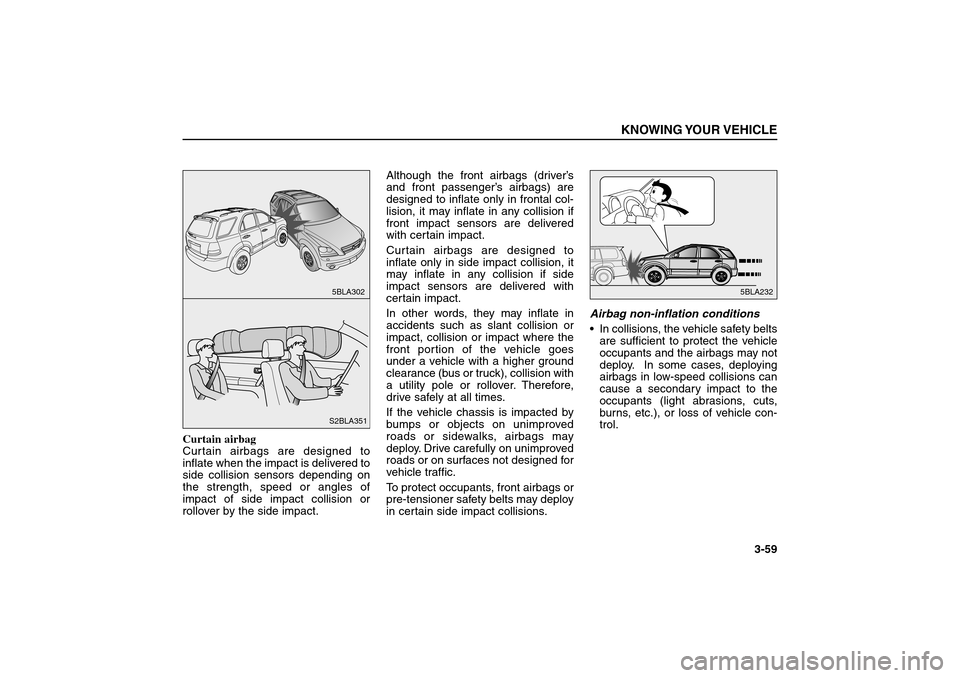
Curtain airbag
Curtain airbags are designed to
inflate when the impact is delivered to
side collision sensors depending on
the strength, speed or angles of
impact of side impact collision or
rollover by the side impact.Although the front airbags (driver’s
and front passenger’s airbags) are
designed to inflate only in frontal col-
lision, it may inflate in any collision if
front impact sensors are delivered
with certain impact.
Curtain airbags are designed to
inflate only in side impact collision, it
may inflate in any collision if side
impact sensors are delivered with
certain impact.
In other words, they may inflate in
accidents such as slant collision or
impact, collision or impact where the
front portion of the vehicle goes
under a vehicle with a higher ground
clearance (bus or truck), collision with
a utility pole or rollover. Therefore,
drive safely at all times.
If the vehicle chassis is impacted by
bumps or objects on unimproved
roads or sidewalks, airbags may
deploy. Drive carefully on unimproved
roads or on surfaces not designed for
vehicle traffic.
To protect occupants, front airbags or
pre-tensioner safety belts may deploy
in certain side impact collisions.Airbag non-inflation conditions
In collisions, the vehicle safety belts
are sufficient to protect the vehicle
occupants and the airbags may not
deploy. In some cases, deploying
airbags in low-speed collisions can
cause a secondary impact to the
occupants (light abrasions, cuts,
burns, etc.), or loss of vehicle con-
trol.
KNOWING YOUR VEHICLE
3-59
5BLA232
5BLA302S2BLA351
BL-ENG (CAN)-3.qxd 7/28/05 5:52 PM Page 59
Page 69 of 312
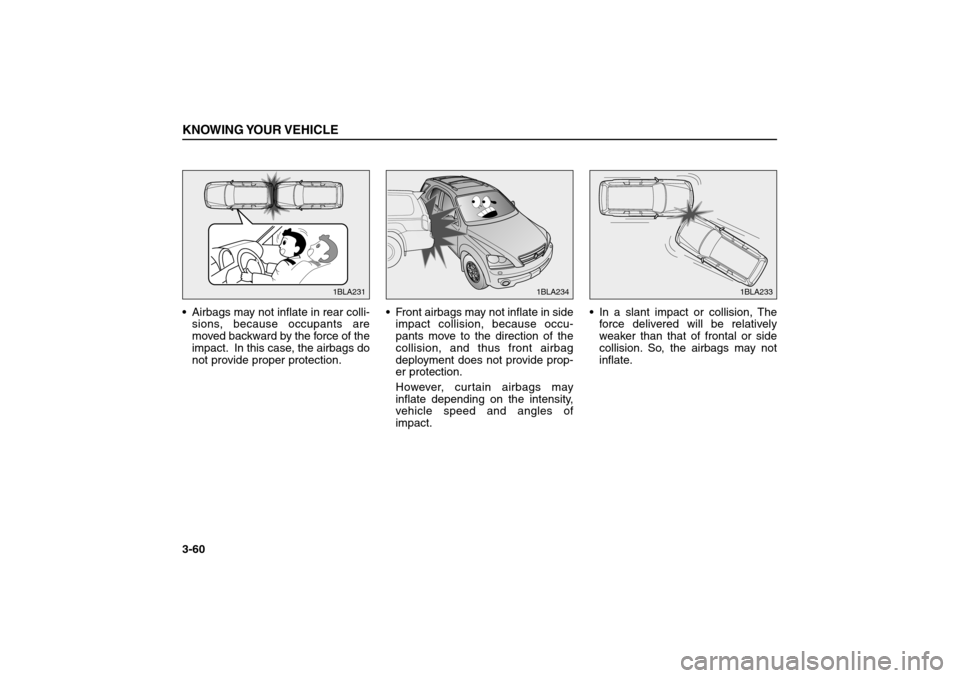
Airbags may not inflate in rear colli-
sions, because occupants are
moved backward by the force of the
impact. In this case, the airbags do
not provide proper protection.Front airbags may not inflate in side
impact collision, because occu-
pants move to the direction of the
collision, and thus front airbag
deployment does not provide prop-
er protection.
However, curtain airbags may
inflate depending on the intensity,
vehicle speed and angles of
impact.In a slant impact or collision, The
force delivered will be relatively
weaker than that of frontal or side
collision. So, the airbags may not
inflate.KNOWING YOUR VEHICLE3-60
1BLA233
1BLA231
1BLA234
BL-ENG (CAN)-3.qxd 7/28/05 5:52 PM Page 60
Page 70 of 312
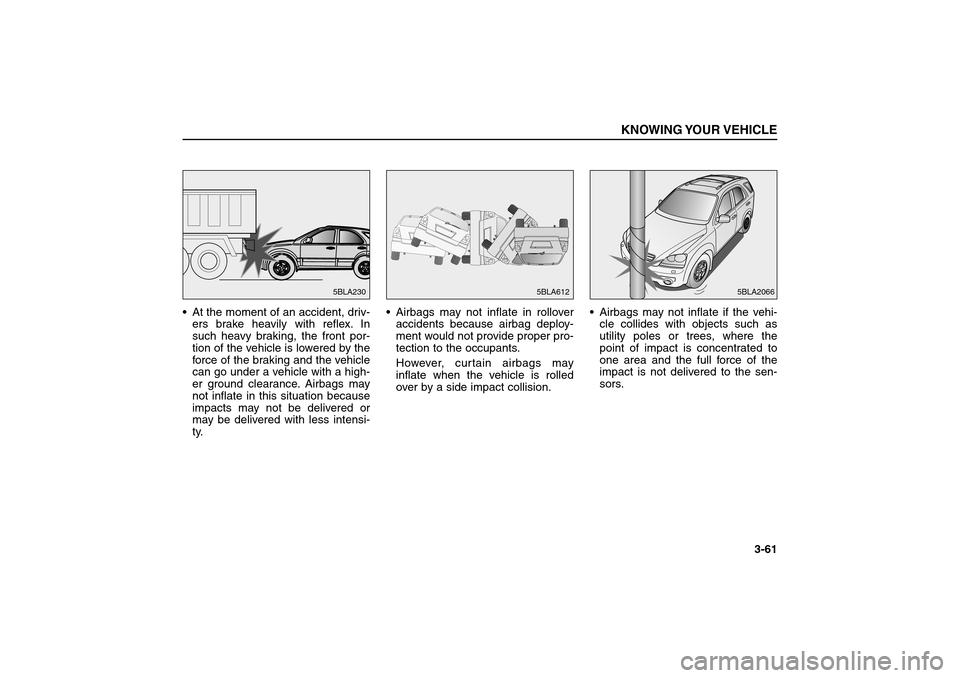
At the moment of an accident, driv-
ers brake heavily with reflex. In
such heavy braking, the front por-
tion of the vehicle is lowered by the
force of the braking and the vehicle
can go under a vehicle with a high-
er ground clearance. Airbags may
not inflate in this situation because
impacts may not be delivered or
may be delivered with less intensi-
ty.Airbags may not inflate in rollover
accidents because airbag deploy-
ment would not provide proper pro-
tection to the occupants.
However, curtain airbags may
inflate when the vehicle is rolled
over by a side impact collision.Airbags may not inflate if the vehi-
cle collides with objects such as
utility poles or trees, where the
point of impact is concentrated to
one area and the full force of the
impact is not delivered to the sen-
sors.
KNOWING YOUR VEHICLE
3-61
5BLA2066
5BLA230
5BLA612
BL-ENG (CAN)-3.qxd 7/28/05 5:52 PM Page 61